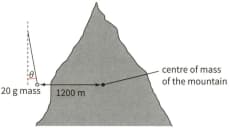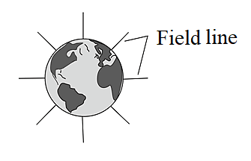An astronaut is on a planet of mass and radius , where is the mass of the Earth and is the radius of the Earth.
What is the gravitational field strength at the surface of the planet?
What is the gravitational field strength at the surface of the planet?

Important Questions on Gravitational Fields
Consider the dwarf planet Pluto to be an isolated sphere of radius and mass of What is the gravitational potential at the surface of Pluto?
It is suggested that the mass of a mountain could be measured by the deflection from the vertical of a suspended mass. This diagram shows the principle.

(a) Copy the diagram and draw arrows to represent the forces acting on the mass. Label the arrows.
It is suggested that the mass of a mountain could be measured by the deflection from the vertical of a suspended mass. This diagram shows the principle.

(b) The whole mass of the mountain, , may be considered to act at its centre of mass. Calculate the horizontal force on the mass due to the mountain.
It is suggested that the mass of a mountain could be measured by the deflection from the vertical of a suspended mass. This diagram shows the principle.

Compare the force calculated in part b with the Earth's gravitational force on the mass.
This diagram shows the Earth's gravitational field.

Copy the diagram and add arrows to show the direction of the field.
This diagram shows the Earth's gravitational field.

Explain why the formula for potential energy gained can be used to find the increase in potential energy when an aircraft climbs to a height of , but cannot be used to calculate the increase in potential energy when a spacecraft travels from the Earth's surface to a height of .
Mercury, the smallest of the eight recognised planets, has a diameter of and a mean density of . Calculate the gravitational field at its surface.
